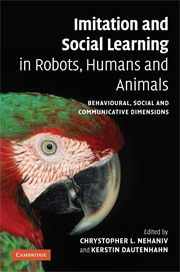 Imitation and Social Learning in Robots, Humans and Animals
Imitation and Social Learning in Robots, Humans and Animals Book contents
- Frontmatter
- Contents
- List of plates
- List of figures
- List of tables
- List of contributors
- Introduction: the constructive interdisciplinary viewpoint for understanding mechanisms and models of imitation and social learning
- Part I Correspondence problems and mechanisms
- Part II Mirroring and ‘mind-reading’
- Part III What to imitate?
- Part IV Development and embodiment
- 10 Copying strategies by people with autistic spectrum disorder: why only imitation leads to social cognitive development
- 11 A Bayesian model of imitation in infants and robots
- 12 Solving the correspondence problem in robotic imitation across embodiments: synchrony, perception and culture in artifacts
- Part V Synchrony and turn-taking as communicative mechanisms
- Part VI Why imitate? – Motivations
- Part VII Social feedback
- Part VIII The ecological context
- Index
- Plate section
- References
12 - Solving the correspondence problem in robotic imitation across embodiments: synchrony, perception and culture in artifacts
Published online by Cambridge University Press: 10 December 2009
- Frontmatter
- Contents
- List of plates
- List of figures
- List of tables
- List of contributors
- Introduction: the constructive interdisciplinary viewpoint for understanding mechanisms and models of imitation and social learning
- Part I Correspondence problems and mechanisms
- Part II Mirroring and ‘mind-reading’
- Part III What to imitate?
- Part IV Development and embodiment
- 10 Copying strategies by people with autistic spectrum disorder: why only imitation leads to social cognitive development
- 11 A Bayesian model of imitation in infants and robots
- 12 Solving the correspondence problem in robotic imitation across embodiments: synchrony, perception and culture in artifacts
- Part V Synchrony and turn-taking as communicative mechanisms
- Part VI Why imitate? – Motivations
- Part VII Social feedback
- Part VIII The ecological context
- Index
- Plate section
- References
Summary
The Agent-based perspective
Imitation is a powerful learning mechanism and a general agent-based approach must be used in order to identify the most interesting and significant problems, rather than the prominent ad hoc approaches in imitation robotics research so far. The traditional approach concentrates in finding an appropriate mechanism for imitation and developing a robot control architecture that identifies salient features in the movements of an (often visually observed) model, and maps them appropriately (via a built-in and usually static method) to motor outputs of the imitator (Kuniyoshi et al., 1994, 1990). Model and imitator are usually not interacting with each other, neither do they share and perceive a common context. Effectively this kind of approach limits itself to answering the question of how to imitate for a particular robotic system and its particular imitation task. This has led to many diverse approaches to robot controllers for imitative learning that are difficult to generalize across different contexts and to different robot platforms. In contrast to the above, the agent-based approach for imitation considers the behaviour of an autonomous agent in relation to its environment, including other autonomous agents. The mechanisms underlying imitation are not divorced from the behaviour-in-context, including the social and non-social environments, motivations, relationships among the agents, the agents individual and learning history etc. (Dautenhahn and Nehaniv, 2002).
Such a perspective helps unfold the full potential of research on imitation and helps in identifying challenging and important research issues.
- Type
- Chapter
- Information
- Imitation and Social Learning in Robots, Humans and AnimalsBehavioural, Social and Communicative Dimensions, pp. 249 - 274Publisher: Cambridge University PressPrint publication year: 2007
References
- 4
- Cited by


